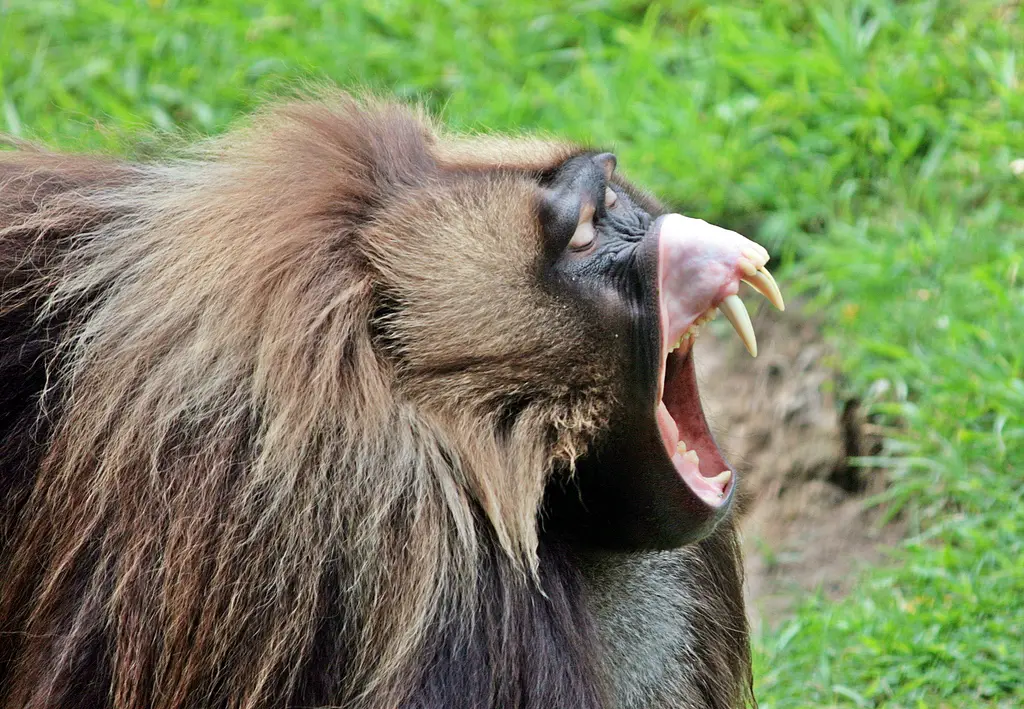The gelada (Theropithecus gelada) is a large primate with the brown stocky body. It occurs in the Ethiopian Highlands. The gelada is also known as ‘bleeding-heart monkey’ or gelada baboon. Grasses make up ninety percent of the baboon’s diet. The monkey prefers to make habitats on rocky areas or cliffs where it could safely spend a night.
Gelada Baboon Facts
Anatomy
- Adult geladas are primarily distinguished by the pinkish red naked skin that is prominent on its chest. The entire body is covered with brown buff pelage except for the face which is hairless.
- The chimp-like snouts have rounded ends.
- The face is dark brown to black in color and so as its arms and feet.
- Gelada baboon has got a short tail. It is 30 and 50 cm (11.8 and 19.7in) long.
- Males are likely to show dense hair on the back as compared to females.
- Males are larger than the females. The mean weight of males is about 18.5 kg (40.8 lb) while females weigh 11 kg (24.3 lb).
- The head-body-length of adult geladas averages 50 and 75 cm (19.7 and 29.5 in).

Geographic Range
- Geladas are widely distributed on the high mountains of Ethiopia including Awash River, Blue Nile River, and south of the Tacazze River.
- The Siemens Mountains host the largest concentration of gelada baboons. Some of its isolated population also lives along the upper Wabi-Shebeli River (Arusi Region).
- In many of its ranges, the baboon is found in scattered population. It prefers to find home near cliffs or gorges.
- The total population of gelada baboons is about 250,000 remaining in the wild.
Habitat
- Geladas are thought to make homes in high open plateaus with an altitude of about 1500 – 4500 m. However the ideal elevation at which large number of baboons is found at 2000 – 3000 meters.
- They will also occupy habitats such as montane grasslands especially those that provide the mixture of dense thickets and bushes. Geladas fancy living in treeless grasslands.
- Gelada’s habitats are abundant in bush level vegetation for e.g. herbs and grasses. While they spend all night on cliffs geladas never go far off from the cliffs even in daylight hours.
- As compared to the lowland regions, the geladas’ habitats are not only cooler but less arid.
- The heavy rainfall starts from June to September on the Amhara Plateau. The gelada’s habitats receive mean annual rainfall of about 120 cm (47.2 in).
Feeding Ecology & Diet
- Geladas are typically graminivorous species. They are genuine grazers and may often eat roots, rhizomes, herbs, and flowers.
- The baboon chews as efficiently as zebras do. They do not only rely on seeds of grasses but geladas also consume the leaves.
- Geladas chew many small plants, thistles, insects, flowers, creepers, herbs, and fruits.
- Insects form only a small portion of gelada’s diet.

Behavior
- Gelada baboons are diurnal species.
- Geladas are believed to be highly terrestrial primates. They spend many hours foraging on the ground. Sometimes they may find food in bushes.
- They are believed to spend 35.7 to 62.3% on feeding, on traveling 14.7 to 20.4%, on resting 2 to 26.3%, and 16 – 20% on the rest of the social activities.
- Baboons remain active around 11 – 12 hours a day.
- They travel in order to find food. Every day geladas move 600-2160 m but larger groups are likely to travel great distances.
- The home range of geladas is about 0.78 and 3.44 km2 (0.3 and 1.3 mi2).
- There are 60 individuals in a single group. Each herd consists of 2 – 15 males and 1 – 12 females. Sometimes the young bachelor forms their separate group which does not include any female. They may form groups as large as containing 400 individuals.
- Geladas have a range of vocalisations but for every single purpose they utter different calls.
- The average life expectancy of wild gelada baboons is 14 years while in captivity they live up to 30 years.
Reproductive Biology
- A female usually gives birth at night. Newborns are born blind and they have red faces.
- The young climb on the mother’s back for up to 35 days. They will be independent after 450 days.
- Females attain maturity when they reach 3 years of age. Males become mature at 4 – 5 years age.
Conservation Status
Least Concern






Leave a Reply